As a parent, I always strive to create a safe and nurturing environment for my family. An essential aspect of cultivating a healthy home is choosing the right furniture that’s free from toxins and chemicals.
In recent years, I’ve discovered numerous sustainable and eco-friendly furniture brands that offer non-toxic furniture materials for families. In this guide, I’ll share my findings on non-toxic furniture materials and discuss their importance in designing a safe and eco-friendly space for your loved ones.
Key Takeaways
- Non-toxic furniture materials reduce exposure to harmful chemicals and promote better indoor air quality.
- Eco-friendly furniture brands like Medley, TFS Natural Home, and Avocado offer a range of non-toxic furniture materials.
- Solid wood, bamboo, and natural textiles such as organic cotton, wool, and hemp provide safe, renewable material choices.
- Natural latent foam, recycled materials, and non-toxic metals and stones are other safe alternatives for family-oriented furniture.
- Natural finishes like beeswax, shellac, and linseed oil minimize the release of harmful VOCs, further improving the safety of your home.
The Top 9 Non-Toxic Furniture Materials
| Material | Description | Benefits |
|---|---|---|
| 1. Solid Wood | Wood from sustainably managed forests, without chemical treatments or finishes. | Durable, renewable, biodegradable, natural aesthetic. |
| 2. Bamboo | A fast-growing, sustainable alternative to traditional wood. Often used in flooring, furniture, and decor. | Strong, lightweight, renewable, versatile. |
| 3. Organic Cotton | Cotton grown without pesticides or synthetic fertilizers, used in upholstery and textiles. | Soft, hypoallergenic, sustainable, breathable. |
| 4. Wool | Natural fiber from sheep, used in rugs, upholstery, and bedding. Naturally flame-resistant and durable. | Renewable, biodegradable, insulating, durable. |
| 5. Natural Latex | Sap from rubber trees, used in mattresses and cushions. Free from synthetic materials and harmful chemicals. | Supportive, durable, biodegradable, hypoallergenic. |
| 6. Recycled Metal | Metals like aluminum or steel, repurposed for furniture use. Reduces waste and energy consumption compared to new metal production. | Durable, recyclable, versatile, often lightweight. |
| 7. Glass | Often recycled glass used in tabletops and decorative elements. Eco-friendly and versatile. | Recyclable, non-toxic, durable, easy to clean. |
| 8. Hemp Fabrics | Made from the fibers of the hemp plant, used in textiles and upholstery. Grown without the need for excessive water or pesticides. | Durable, sustainable, biodegradable, mildew-resistant. |
| 9. Cork | Harvested from the bark of cork oak trees without harming the tree, used in flooring and furniture. Offers a unique texture and is naturally antimicrobial. | Renewable, biodegradable, lightweight, sound-absorbing. |
Each of these materials offers a unique set of benefits, making them excellent choices for creating a healthy, sustainable, and eco-friendly living space.
The Hidden Dangers of Conventional Furniture Materials
When it comes to conventional furniture, a lack of regulatory disclosure requirements can lead to undisclosed harmful elements, many of which pose a serious threat to indoor air quality. Furniture often releases volatile organic compounds (VOCs) and semi-volatile organic compounds (SVOCs) through off-gassing, which can cause a variety of health problems such as throat, nose, and eye irritation, headaches, nausea, and damage to the liver, kidney, and central nervous system (CNS).
Concerns include the presence of flame retardants, formaldehyde, phthalates, and other harmful compounds that not only escape into the air but also settle into dust, increasing exposure risks, especially for children.
Puustelliusa.com: Choose dressers made from rescued solid wood like Douglas Fir, which are free from MDF and particle board, adding character and eco-friendliness to your home.
Let’s take a closer look at some of the most prevalent toxic chemicals in furniture that contribute to these dangerous furniture materials:
- Flame retardants: Often added to upholstered furniture and mattresses, flame retardants can release harmful chemicals into the air, resulting in negative health effects.
- Formaldehyde: A common ingredient of adhesives and resins, formaldehyde can be found in particleboard, plywood, and fiberboard. It off-gases into the air, potentially causing respiratory problems and allergy symptoms.
- Phthalates: Found in certain plastic materials like PVC and vinyl, phthalates can leach out over time, leading to potential health issues, particularly in children.
- Per- and polyfluoroalkyl substances (PFAS): Used in stain-resistant coatings for carpets and upholstery, PFAS chemicals have been linked to various health problems, including immune system disorders, thyroid disease, and even cancer.
Families need to be aware of these hidden dangers lurking in conventional furniture materials and take steps to minimize exposure risks. Fortunately, eco-friendly alternatives available do not contain these harmful chemicals.
| Chemical | Found in | Potential Health Effects |
|---|---|---|
| Flame retardants | Upholstered furniture, mattresses | Respiratory issues, endocrine disruption, cancer |
| Formaldehyde | Particleboard, plywood, fiberboard | Irritation of eyes, nose, and throat, respiratory problems, cancer |
| Phthalates | PVC, vinyl | Endocrine disruption, reproductive issues, developmental problems |
| PFAS chemicals | Stain-resistant coatings for carpets and upholstery | Immune system disorders, thyroid disease, cancer |
Choosing furniture made from non-toxic materials and relying on trustworthy manufacturers can create a healthier living space and protect your family from harmful chemicals.
Understanding VOCs and Their Impact on Indoor Air Quality
While many people are aware of the pollutants outdoors, they often overlook harmful chemicals inside their homes, specifically those related to volatile organic compounds (VOCs) in furniture. VOCs are a major contributor to indoor air pollution, posing significant health risks. In this section, we will explore how VOCs impact indoor air quality, their sources in furniture, and the potential health effects of these harmful substances.
VOCs are emitted as gases from a wide array of products, including off-gassing furniture, paint, adhesives, and cleaning supplies. These compounds can lead to various adverse health effects, such as eye, nose, and throat irritation, headaches, loss of coordination, nausea, and even damage to vital organs like the liver, kidneys, and central nervous system. Long-term exposure to high concentrations of VOCs can also increase the risk of cancer.
“Thousands of products can emit VOCs, which have the potential to cause serious harm to our health and indoor air quality.”
Among the most common VOCs in off-gassing furniture are substances such as formaldehyde, phthalates, and other semi-volatile organic compounds (SVOCs). These compounds can off-gas for extended periods, long after the ‘new’ smell of furniture disappears. This persistent emission of harmful gases from your furniture can continuously affect the quality of the air you and your family breathe.
- Formaldehyde: A common VOC found in wood composite furniture, adhesives, and varnishes.
- Phthalates: Widely used in plastics and vinyl materials, as well as some paints and adhesives.
- Other SVOCs: Includes substances such as flame retardants, which can be found in some upholstered furniture and mattresses.
Due to the presence of such VOCs in furniture, it is essential to understand their health effects and take necessary precautions to minimize their impact on indoor air quality.
| Symptom | Description |
|---|---|
| Eye, nose, and throat irritation | Caused by exposure to VOCs, often experienced as burning or itching sensations or increased mucous production. |
| Headaches | Can occur due to exposure to high levels of VOCs, often accompanied by dizziness or light-headedness. |
| Loss of coordination | Resulting from neurological effects of VOC exposure, which can lead to difficulties with balance and movement. |
| Nausea | A common response to exposure to toxic VOCs, sometimes accompanied by vomiting. |
| Organ damage | Long-term exposure to high levels of VOCs can cause damage to the liver, kidneys, and central nervous system. |
By being mindful of the VOCs impact on indoor air quality and their sources, you can take proactive steps to reduce your family’s exposure to these harmful chemicals and create a healthier living environment for everyone.
Why Non-Toxic Materials Matter for Your Family’s Well-being
When choosing furniture for your home, it’s essential to prioritize non-toxic materials for your family’s well-being. Toxic chemicals commonly found in furniture can have significant health effects, especially among more vulnerable family members such as children and babies. In this section, we will discuss the health risks associated with chemical exposure from furniture and the importance of selecting furniture without toxic components for a healthier home.
Health Effects of Toxic Chemical Exposure
Conventional furniture materials, such as foam and flame retardants, can cause a range of health problems due to the presence of chemicals like polybrominated diphenyl ethers and phthalates. These chemicals can lead to irritation, respiratory issues, and potential damage to the liver, kidneys, and central nervous system. In some cases, prolonged exposure may increase the risk of developing cancer.
Furthermore, children exposed to toxic chemicals from furniture may experience poor neurodevelopment, impacting their cognitive abilities and overall development.
“Your family’s health can be greatly impacted by the furniture you choose, which is why selecting non-toxic options is crucial to well-being.”
Protecting Vulnerable Family Members
Babies and toddlers are particularly susceptible to the dangers of toxic furniture, as they are closer to the ground and regularly touch potentially contaminated surfaces while crawling and playing. Exposure to harmful chemicals is especially concerning for these young family members, as their developing immune systems are more vulnerable to the effects of toxin exposure.
The Filtery: Avoid furniture with polyurethane foam which often contains flame retardants, as these chemicals have been found not to effectively slow down fires.
To properly protect the health of your children and other family members, it is essential to opt for furniture made from non-toxic materials. You can safeguard their health by thoroughly researching and choosing furniture that is free of chemicals, such as those containing:
- No flame retardants
- Furniture without foam
- Non-toxic paint and finishes
- Eco-friendly textiles
By investing in non-toxic, chemical-free furniture, you are actively taking steps to create a healthier living environment in which your family can thrive. Just as we are careful about the food we eat and the products we use in our daily lives, it’s vital to be vigilant about the materials used in our furniture and our homes.
Solid Wood: A Timeless and Safe Furniture Choice
Solid wood offers a classic and timeless aesthetic for any home, while also providing a naturally safe and non-toxic choice for furniture. It can be crafted from a variety of appealing and eco-friendly tree species, each with its own unique characteristics.
Some popular choices for solid wood furniture include pine, maple, oak, walnut, cherry, ash, poplar, and alder.
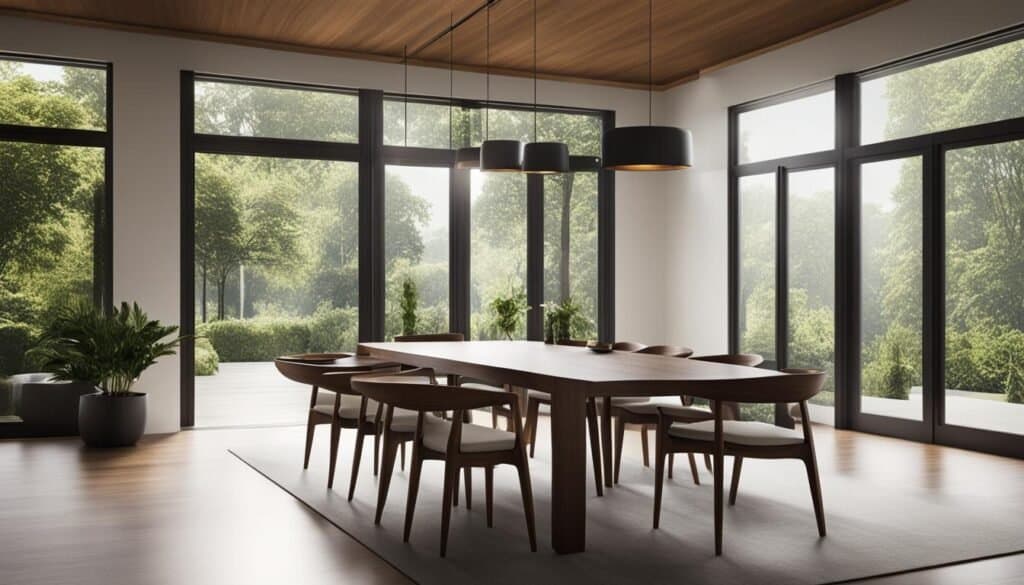
Wooden furniture made from these species is not only visually stunning but also offers impressive durability and longevity. Solid wood furniture can serve as a lasting investment piece, with many heirloom-quality items enduring for decades and even generations if sustainably sourced and treated with non-toxic finishes.
One respected brand that champions the use of solid wood in their products is Medley. They take great care to ensure that their furniture is free of VOCs and harmful additives, maintaining a commitment to offering safe and toxin-free furnishing options for the eco-conscious consumer.
| Wood Species | Characteristics |
|---|---|
| Pine | Lightweight and cost-effective, pine features a distinct grain pattern and pale color. |
| Maple | Noted for its strength and durability, maple has a fine grain and a consistent, light color. |
| Oak | Oak is a heavy, strong wood that showcases a distinctive grain pattern. |
| Walnut | Walnut is prized for its rich color variation and unique grain, offering a high-end, luxurious appearance. |
| Cherry | With a beautiful, reddish-brown hue and fine grain, cherry wood ages gracefully over time. |
| Ash | A strong, dense wood, ash has a light color and prominent, straight grain. |
| Poplar | Known for its affordability and workability, poplar boasts a fine grain and light color. |
| Alder | Alder is a versatile wood with a uniform texture and soft, reddish-brown color. |
As you consider furnishing your home with pieces that prioritize both aesthetics and safety, keep in mind the numerous benefits of solid wood options. With a wide array of species to choose from, designing stunning and eco-friendly spaces is easier than ever.
Bamboo: The Sustainable Star of Eco-Friendly Interiors
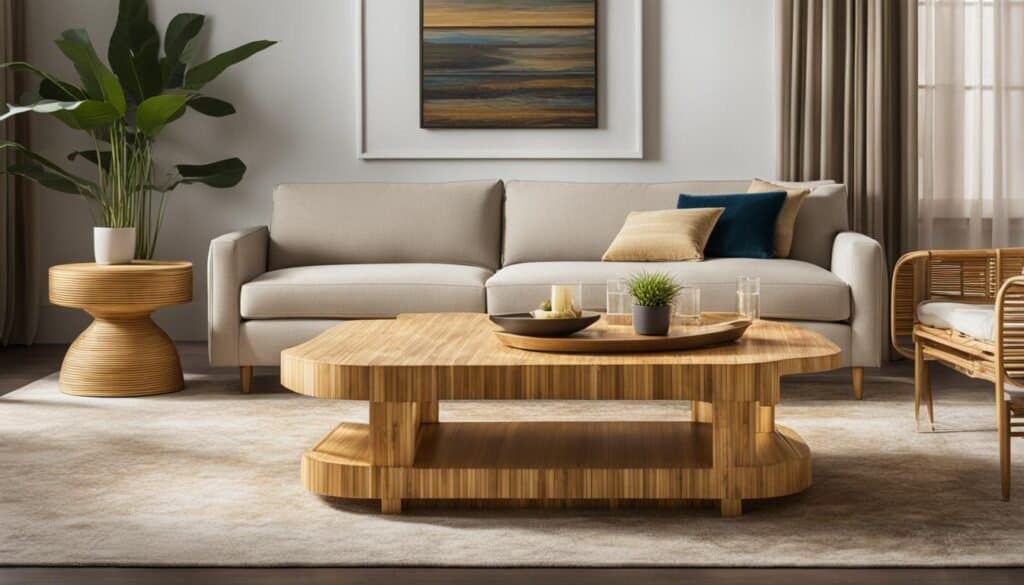
Quickly growing in popularity among eco-conscious consumers, bamboo has emerged as a leading sustainable material for creating beautiful and eco-friendly interiors. Its innate strength, durability, and rapid renewability make it an ideal choice for sustainable furniture.
Unlike traditional hardwoods that can take decades to mature, bamboo can be harvested every 3-5 years, making it a rapidly renewable resource. Moreover, it is naturally resistant to pests and diseases, eliminating the need for harmful chemical pesticides or treatments.
Recognized for its strength and sustainability, bamboo is often used in non-toxic furniture brands like Medley, which creates products that are free from harsh chemicals and flame retardants.
By choosing furniture made from bamboo, you contribute to lowering your environmental footprint without sacrificing style or quality. Below are some key benefits of incorporating bamboo furniture into your home:
- Highly renewable and fast-growing resource
- Natural resistance to pests and diseases, eliminating the need for toxic chemicals
- Strength and durability comparable to hardwoods, making it long-lasting
- Lightweight and easily transportable
- Provides a naturally warm and inviting aesthetic to your interior
Bamboo furniture can be found in various forms, such as chairs, tables, shelves, and cabinetry. Its versatility and adaptability make it a perfect choice for any room in your home.
| Product | Material | Brand |
|---|---|---|
| Bamboo Dining Table | Sustainable bamboo | Medley |
| Eco-friendly Bamboo Chair | Responsibly-sourced bamboo | Greenington |
| Modern Bamboo Shelving Unit | Bamboo plywood | Legare |
| Stylish Bamboo Coffee Table | High-quality bamboo | Haiku Designs |
Embracing bamboo furniture in your home is a significant step towards establishing an eco-friendly interior, showcasing your commitment to preserving our planet’s resources for future generations. By choosing sustainable materials like bamboo, you can create a healthier and more environmentally responsible living space.
Natural Textiles: Organic Cotton, Wool, and Hemp Fabrics
Natural textiles offer excellent eco-friendly and non-toxic furniture options, making them an essential choice for modern family homes. Among these materials, organic cotton, wool, and hemp stand out for their sustainable properties and luxurious feel. In addition, these fabrics can be combined with other sustainable materials like linen, jute, silk, modal, tencel, seagrass, and rattan to create stunning, long-lasting pieces that elevate the appeal of your bedroom furniture.
Organic Cotton: Soft and Chemical-Free
Organic cotton is a highly versatile natural textile renowned for its softness, comfort, and breathability. The absence of harmful chemicals during its cultivation and production process makes organic cotton an ideal choice for upholstery, bedding, and mattresses. Brands such as TFS Natural Home utilize USDA organic cotton, GOLS-certified organic latex, and GOTS-certified organic wool to ensure their furniture is safe and chemical-free.
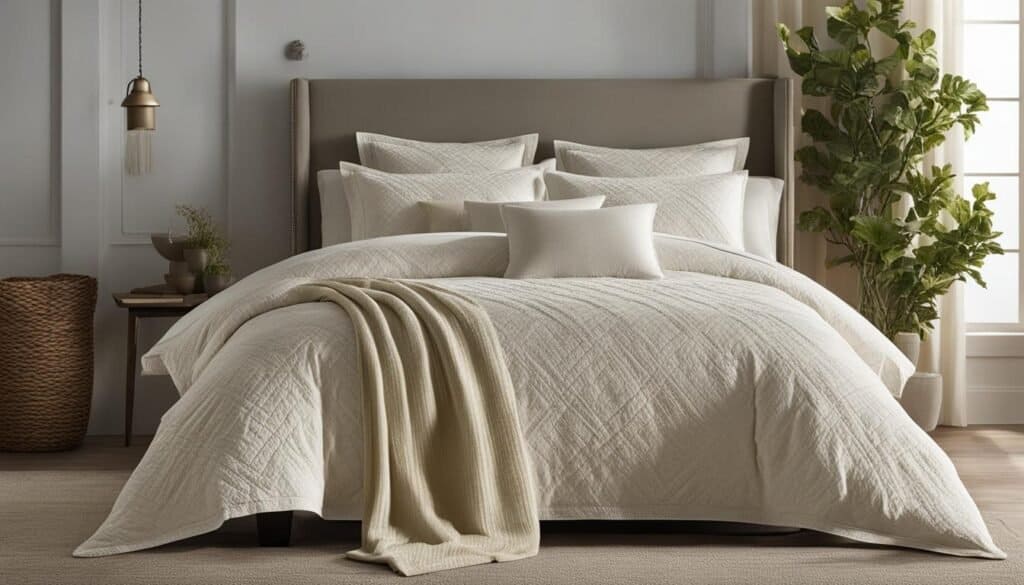
Other remarkable natural textiles that contribute to creating eco-friendly furniture include:
- Wool: This cozy and naturally flame-resistant material is perfect for upholstered furniture, pillows, and blankets.
- Hemp: Known for its durability, hemp fabric is an excellent option for upholstered furniture, curtains, and rugs.
- Linen: A breathable and hypoallergenic fabric that is ideal for bedding and curtains.
- Jute: A natural fiber that is often woven into rugs and used for rope accents in eco-friendly furniture designs.
- Silk: A luxurious and lightweight fabric that adds a touch of elegance to pillows, curtains, and bedding.
- Modal: A soft and biodegradable fabric made from beech trees, often used in bedding and linens.
- Tencel: A sustainable fabric made from eucalyptus wood pulp that boasts excellent moisture-wicking properties.
- Seagrass and Rattan: These natural fibers can be woven together to create stylish and durable furniture pieces.
By incorporating eco-friendly materials like organic cotton, wool, and hemp into your home’s furnishings, you not only contribute to a healthier environment but also ensure the well-being of your loved ones.
In conclusion, natural textiles should be at the forefront of your search for eco-friendly and non-toxic furniture. Investing in such materials not only elevates your living space aesthetically but also ensures the safety and health of your family.
The Benefits of Choosing Furniture Made with Natural Latex Foam
When prioritizing health and sustainability in our homes, the materials used in our furniture play a significant role. One standout material in the realm of non-toxic furniture is natural latex foam. With its eco-friendly properties and health benefits, it’s a top choice for creating safer and more sustainable furniture.
Natural latex foam is derived from the sap of rubber trees, which makes it a natural and renewable resource. Furniture made from natural latex foam is not only eco-friendly but also offers multiple benefits for our well-being.
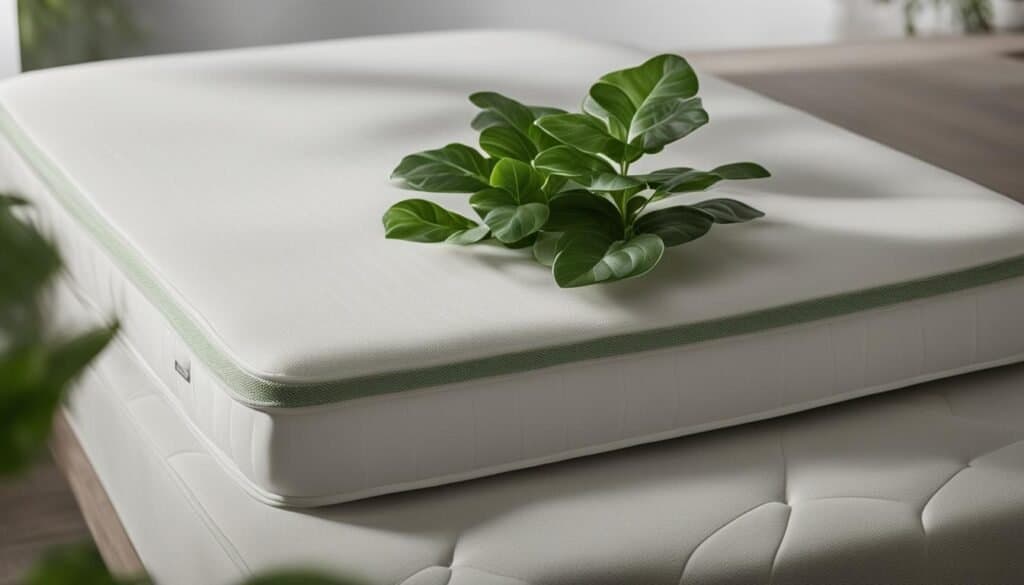
Non-toxic furniture brands like Avocado have adopted natural latex foam in their products, combining it with materials like organic wool and cotton. This powerful combination results in furniture free of VOCs, chemical adhesives, and flame retardants.
The result? A healthier home environment and sustainable furniture choices without compromising on quality and durability.
Here are some of the key benefits of choosing furniture made with natural latex foam:
- Biodegradable and minimizes landfill waste
- Free of harmful chemicals, flame retardants, and adhesives
- Hypoallergenic and antimicrobial properties
- Resilient, durable, and comfortable
- Supports fair trade practices and agricultural communities
When you choose furniture made with natural latex foam, you make a conscious decision to prioritize sustainable sources and non-toxic materials in your home. Not only are you investing in healthier furniture, but you are also supporting the environment and the people behind these eco-friendly products.
Recycled Materials: How They Contribute to a Healthier Home
Recycled materials play a significant role in fostering a healthier home by reducing waste and minimizing exposure to toxins. Furniture created from recycled materials, like Sabai’s sofas and chairs made from upcycled water bottles or recycled velvet, offers eco-friendly and safe options. These materials help lower the environmental impact, without compromising on style or durability.
- Recycled polyester – Made from used plastic bottles, recycled polyester reduces the need for virgin polyester production, leading to less pollution and waste. This versatile fabric is used in many eco-friendly furniture options, like upholstered sofas and chairs.
- Reclaimed wood – Harvested from old buildings, barns, and other sources, reclaimed wood offers a sustainable and less toxic alternative to new lumber, which may contain harmful chemicals or contribute to deforestation. Furniture made with reclaimed wood often maintains the character and charm of the original source material while being highly durable.
- Recycled metal – By reusing scrap metal, manufacturers can create new pieces of furniture that give a second life to materials that would otherwise go to waste. From table bases to chair frames, recycled metal options provide a more sustainable and less toxic choice for your home.
Choosing furniture made with recycled materials supports a healthier home environment by limiting exposure to the toxic chemicals commonly found in traditionally-produced furniture. Furthermore, it encourages sustainable living and preserves valuable natural resources for future generations.
“Recycled materials not only reduce waste but also contribute to a healthier home environment by minimizing exposure to harmful chemicals.”
In addition to the benefits of using recycled materials, several brands focus on incorporating these eco-friendly options into their furniture lines. For example, Sabai offers a range of sofas and chairs made from upcycled water bottles turned into fabric.
| Brand | Featured Recycled Material | Product Examples |
|---|---|---|
| Sabai | Recycled polyester | Sofas and chairs |
| Urban Wood Goods | Reclaimed wood | Tables and shelving |
| Emeco | Recycled aluminum | Chairs and stools |
By considering furniture made with recycled materials, you can create a healthier living space for your family while simultaneously promoting sustainable living and supporting brands that prioritize eco-friendly practices.
Non-Toxic Metals and Stones: Solid Brass, Copper, and Stone Surfaces
When considering sustainable and non-toxic furniture materials, it’s important not to overlook the benefits of using non-toxic metals and stone surfaces. These materials can help to create a harmonious balance between aesthetics, functionality, and environmental responsibility within your home. In this section, we will explore the qualities and benefits of selecting non-toxic metals like solid brass and copper, along with stone surfaces such as marble, granite, quartz, and soapstone for your eco-friendly space.
Solid brass and solid copper are highly sought-after non-toxic metals to incorporate into furniture designs. They do not off-gas VOCs, ensuring a safer and healthier environment within your home. These metals offer a timeless and elegant look, and their durability ensures they will serve as long-lasting additions to your space. Brass and copper accents can be found in various furniture pieces, adding warmth and character to your eco-friendly and non-toxic home.
Stone surfaces such as marble, granite, quartz, and soapstone offer an excellent alternative to traditional materials and make for striking and functional furniture options. Each of these stones provides unique color patterns and textures, allowing you to customize your space to your preferences without compromising on sustainability.
- Marble: This classic and luxurious surface offers an unmatched beauty and elegance to your furniture pieces. Despite its delicate appearance, marble is incredibly durable and does not off-gas VOCs when utilized correctly.
- Granite: Known for its impressive strength and durability, granite is perfect for creating countertops or tabletops that are non-toxic and visually appealing.
- Quartz: A highly durable, versatile, and low-maintenance option, quartz is an excellent choice for furniture that requires resilience and longevity.
- Soapstone: This unique, nonporous natural stone resists stains and scratches, making it an attractive and sustainable solution for your toxin-free home.
As you can see, non-toxic metals and stones provide a wealth of options when designing your eco-friendly home. By incorporating these materials in your space, you can reduce your environmental impact and create a beautiful, toxin-free environment for your family. Make sure to choose sustainable materials from responsible suppliers who prioritize ethical sourcing and production practices, ensuring your home remains beautiful and healthy for years to come.
The Role of Natural Finishes: Beeswax, Shellac, and Linseed Oil
When it comes to creating non-toxic furniture, one cannot overlook the significance of natural finishes such as beeswax, shellac, and linseed oil. These eco-friendly finishes not only protect the surfaces of wood and other materials but also ensure the furniture remains free from the release of harmful VOCs and chemicals. Companies like Medley are a testament to this, as they employ plant-based, zero-VOC finishes that ultimately contribute to a healthier home environment.
Let’s explore each of these three natural finishes and their contribution to non-toxic furniture:
- Beeswax: Extracted from beehives, beeswax brings out the natural beauty of wood while providing a protective coating. It enhances the wood grain, while also protecting against moisture and scratches. Unlike synthetic finishes, it contains no toxic chemicals, making it safe for family members and the environment.
- Shellac: Derived from the secretion of the lac bug, shellac is a versatile and biodegradable finish that seals and protects wooden furniture. Not only does it provide an excellent barrier against water and stains, but it also dries rapidly and is hypoallergenic. This makes it an ideal choice for families looking to create an allergy-free home atmosphere.
- Linseed Oil: Obtained from the seeds of the flax plant, linseed oil is a natural finish that penetrates deep into the wood, protecting it from wear and tear. It offers water resistance and enhances the natural color and grain of the wood. Although it takes longer to dry compared to other natural finishes, linseed oil is a perfect option for those who prioritize a non-toxic living space.
Choose natural finishes like beeswax, shellac, and linseed oil for a healthier, more eco-friendly home.
Many furniture brands are now recognizing the importance of using natural finishes to promote healthy indoor environments. By opting for eco-friendly finishes, you can create a safer and cleaner living space for your family while also supporting sustainable practices within the furniture industry.
Conclusion on Non-Toxic Furniture
As I reached the end of my journey exploring the eco-friendly furniture guide, it became evident that transitioning to non-toxic living can significantly improve the well-being of my family and contribute to sustainable living. By making healthier furniture choices, we can create a safer environment for ourselves and future generations to come.
There are many fantastic furniture brands to consider, such as Medley, TFS Natural Home, and Avocado, that offer stunning and sustainable designs. By keeping in mind established certifications like GOTS, GOLS, MADE SAFE, UL/Greenguard Gold, and OEKO-TEX, identifying and selecting the ideal furniture becomes much simpler.
In conclusion, adopting non-toxic furniture has never been more accessible, with a myriad of options available that cater to various budgets, preferences, and design sensibilities. By embracing eco-conscious practices and choices, we can build a healthier home and world, one piece of furniture at a time.
FAQ on Non-toxic Furniture Materials for Families
Q: What should I look for in a non-toxic furniture brand?
A: When choosing a non-toxic furniture brand it’s crucial to look out for factors such as certified non-toxic labels, type of materials used, and the furniture-making process. Brands that use organic materials, create formaldehyde-free furniture, and have a transparent and clean manufacturing process are recommended.
Q: Which furniture brand is best known for its non-toxic furniture?
A: One of the best non-toxic furniture brands is West Elm. It’s known for its quality and commitment to sustainable, organic materials. However, it’s always advisable to research different non-toxic furniture brands to find furniture that best meets personal needs and budget.
Q: Is West Elm’s furniture non-toxic and eco-friendly?
A: Yes, West Elm is committed to producing certified non-toxic furniture. Their furniture is made using materials like engineered wood which are eco-friendly and healthy for home environments.
Q: Are there any good non-toxic furniture brands for outdoor furniture?
A: Yes, there are several reputable non-toxic furniture brands offering a great variety of outdoor furniture. It is important though to always ensure that the brand is certified non-toxic and uses materials suited for outside weather conditions.
Q: How can I tell if new furniture is non-toxic?
A: New furniture that is non-toxic usually comes with certifications or labels stating the same. You can also get information about the furniture’s material and manufacturing process from the furniture brand. Always look out for furniture that contains all-natural materials, free from chemicals and treatments.
Q: Where can I find affordable non-toxic furniture?
A: You can find affordable non-toxic furniture from various online and physical stores. Look for affiliate links, discount mom & pop shop, upcoming brands, and furniture stores that stock up on clearance sales. Remember to verify the brand’s commitment to non-toxics before purchasing.
Q: Are flame retardants used in non-toxic furniture?
A: No, non-toxic furniture brands avoid using flame retardants as they can be harmful. Certified non-toxic furniture usually does not contain these chemicals found in conventional furniture.
Q: Can I get non-toxic wooden furniture?
A: Yes, many non-toxic furniture brands offer wooden furniture. These are typically made from naturally sourced timber or engineered wood, with non-toxic, organic finishes applied.
Q: Is the best non-toxic furniture also suitable for office use?
A: Absolutely. Many non-toxic furniture brands offer a variety of office furniture pieces which are safe, healthy, and eco-friendly. This includes chairs, desks, storage units and more.
Q: What kind of non-toxic furniture is suitable for a bedroom?
A: You can find a range of non-toxic furniture suitable for the bedroom. This includes bed frames, wardrobes, drawers, side tables and more. Check for certified non-toxic and ensure the pieces are free from harmful chemicals for a healthier sleep environment.

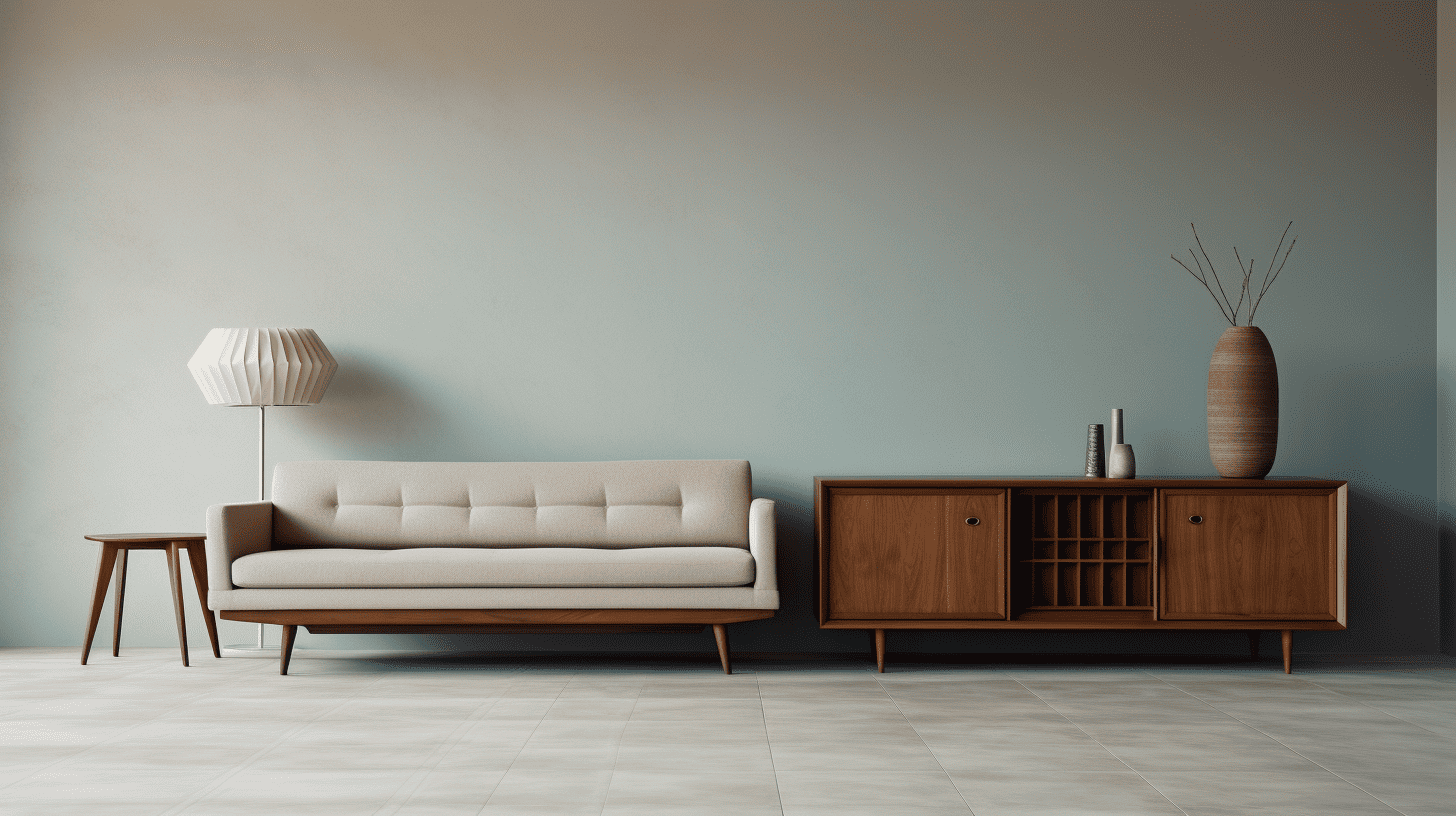



Leave a Reply